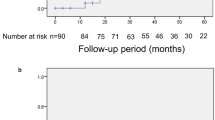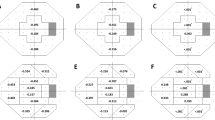Abstract
Purpose
To compare global and regional visual field (VF) progression rates and determine clinical factors associated with rapid VF progression in myopic patients with open-angle glaucoma (OAG) with different disc tilt directions.
Methods
The medical records of 182 eyes from 182 myopic OAG patients with progressive VF deterioration during follow-up were analyzed. The rates of change in the mean thresholds of the global and regional VF areas of the horizontal and vertical disc tilt (HDT and VDT) groups were compared using a linear mixed model after controlling for confounding covariates. Clinical factors associated with rapid VF progression in global and regional VF areas were investigated.
Results
The VDT group showed significantly faster VF progression at inferior regional zones than the HDT group (P < 0.05). Based on a multivariate linear mixed model, VDT was associated with faster bi-hemifield VF progression in the GHT map, whereas HDT was associated with faster single-hemifield VF progression.
Conclusions
Myopic OAG eyes show significantly different regional VF progression rates according to disc tilt direction. VDT is an independent predictor of a rapid rate of regional VF progression in both hemifields, whereas HDT predicts rapid regional VF progression in a single hemifield.





Similar content being viewed by others
References
Doshi A, Kreidl KO, Lombardi L, Sakamoto DK, Singh K (2007) Nonprogressive glaucomatous cupping and visual field abnormalities in young Chinese males. Ophthalmology 114:472–479
Sohn SW, Song JS, Kee C (2010) Influence of the extent of myopia on the progression of normal-tension glaucoma. Am J Ophthalmol 149:831–838
Park HY, Lee K, Park CK (2012) Optic disc torsion direction predicts the location of glaucomatous damage in normal-tension glaucoma patients with myopia. Ophthalmology 119:1844–1851
Lee KS, Lee JR, Kook MS (2014) Optic disc torsion presenting as unilateral glaucomatous-appearing visual field defect in young myopic Korean eyes. Ophthalmology 121:1013–1019
Lee JR, Kim S, Lee JY, Back S, Lee KS, Kook MS (2016) Is myopic optic disc appearance a risk factor for rapid progression in medically treated glaucomatous eyes with confirmed visual field progression? J Glaucoma 25:330–337
Chihara E, Liu X, Dong J, Takashima Y, Akimoto M, Hangai M et al (1997) Severe myopia as a risk factor for progressive visual field loss in primary open-angle glaucoma. Ophthalmologica 211:66–71
Sakata R, Aihara M, Murata H, Mayama C, Tomidokoro A, Iwase A et al (2013) Contributing factors for progression of visual field loss in normal-tension glaucoma patients with medical treatment. J Glaucoma 22:250–254
Lee JY, Sung KR, Han S, Na JH (2015) Effect of myopia on the progression of primary open-angle glaucoma. Invest Ophthalmol Vis Sci 56:1775–1781
Kim TW, Kim M, Weinreb RN, Woo SJ, Park KH, Hwang JM (2012) Optic disc change with incipient myopia of childhood. Ophthalmology 119:21–26.e21-23
Quigley HA, Anderson DR (1977) Distribution of axonal transport blockade by acute intraocular pressure elevation in the primate optic nerve head. Invest Ophthalmol Vis Sci 16:640–644
Quigley HA, Addicks EM (1981) Regional differences in the structure of the lamina cribrosa and their relation to glaucomatous optic nerve damage. Arch Ophthalmol 99:137–143
Quigley HA, Addicks EM, Green WR, Maumenee AE (1981) Optic nerve damage in human glaucoma. II. The site of injury and susceptibility to damage. Arch Ophthalmol 99:635–649
Quigley HA, Hohman RM, Addicks EM, Massof RW, Green WR (1983) Morphologic changes in the lamina cribrosa correlated with neural loss in open-angle glaucoma. Am J Ophthalmol 95:673–691
Burgoyne CF (2011) A biomechanical paradigm for axonal insult within the optic nerve head in aging and glaucoma. Exp Eye Res 93:120–132
Chylack LT Jr, Wolfe JK, Singer DM, Leske MC, Bullimore MA, Bailey IL et al (1993) The lens opacities classification system III. The Longitudinal Study of Cataract Study Group. Arch Ophthalmol 111:831–836
Nicolela MT, Drance SM (1996) Various glaucomatous optic nerve appearances: clinical correlations. Ophthalmology 103:640–649
Wong TY, Klein BE, Klein R, Knudtson M, Lee KE (2003) Refractive errors, intraocular pressure, and glaucoma in a white population. Ophthalmology 110:211–217
Jonas JB, Kling F, Grundler AE (1997) Optic disc shape, corneal astigmatism, and amblyopia. Ophthalmology 104:1934–1937
Brito PN, Vieira MP, Falcao MS, Faria OS, Falcao-Reis F (2015) Optical coherence tomography study of peripapillary retinal nerve fiber layer and choroidal thickness in eyes with tilted optic disc. J Glaucoma 24:45–50
Lee KM, Lee EJ, Kim TW (2015) Lamina cribrosa configuration in tilted optic discs with different tilt axes: a new hypothesis regarding optic disc tilt and torsion. Invest Ophthalmol Vis Sci 56:2958–2967
Leske MC, Heijl A, Hyman L, Bengtsson B (1999) Early manifest glaucoma trial: design and baseline data. Ophthalmology 106:2144–2153
Landis JR, Koch GG (1977) The measurement of observer agreement for categorical data. Biometrics 33:159–174
Shigeeda T, Tomidokoro A, Araie M, Koseki N, Yamamoto S (2002) Long-term follow-up of visual field progression after trabeculectomy in progressive normal-tension glaucoma. Ophthalmology 109:766–770
Smith SD, Katz J, Quigley HA (1996) Analysis of progressive change in automated visual fields in glaucoma. Invest Ophthalmol Vis Sci 37:1419–1428
Katz J, Gilbert D, Quigley HA, Sommer A (1997) Estimating progression of visual field loss in glaucoma. Ophthalmology 104:1017–1025
Yamazaki Y, Yoshikawa K, Kunimatsu S, Koseki N, Suzuki Y, Matsumoto S et al (1999) Influence of myopic disc shape on the diagnostic precision of the Heidelberg Retina Tomograph. Jpn J Ophthalmol 43:392–397
Choi JA, Park HY, Shin HY, Park CK (2014) Optic disc tilt direction determines the location of initial glaucomatous damage. Invest Ophthalmol Vis Sci 55:4991–4998
Samarawickrama C, Mitchell P, Tong L, Gazzard G, Lim L, Wong TY et al (2011) Myopia-related optic disc and retinal changes in adolescent children from Singapore. Ophthalmology 118:2050–2057
Choi JA, Park HY, Shin HY, Park CK (2014) Optic disc characteristics in patients with glaucoma and combined superior and inferior retinal nerve fiber layer defects. JAMA Ophthalmol 132:1068–1075
Boden C, Blumenthal EZ, Pascual J, McEwan G, Weinreb RN, Medeiros F et al (2004) Patterns of glaucomatous visual field progression identified by three progression criteria. Am J Ophthalmol 138:1029–1036
Leung CK, Yu M, Weinreb RN, Lai G, Xu G, Lam DS (2012) Retinal nerve fiber layer imaging with spectral-domain optical coherence tomography: patterns of retinal nerve fiber layer progression. Ophthalmology 119:1858–1866
Gordon MO, Beiser JA, Brandt JD, Heuer DK, Higginbotham EJ, Johnson CA et al (2002) The Ocular Hypertension Treatment Study: baseline factors that predict the onset of primary open-angle glaucoma. Arch Ophthalmol 120:714–720, discussion 829–730
Heijl A, Leske MC, Bengtsson B, Hyman L, Bengtsson B, Hussein M (2002) Reduction of intraocular pressure and glaucoma progression: results from the Early Manifest Glaucoma Trial. Arch Ophthalmol 120:1268–1279
Investigators AGIS (2002) The Advanced Glaucoma Intervention Study (AGIS): 12. Baseline risk factors for sustained loss of visual field and visual acuity in patients with advanced glaucoma. Am J Ophthalmol 134:499–512
Choi J, Lee JR, Lee Y, Lee KS, Na JH, Han S et al (2013) Relationship between 24-hour mean ocular perfusion pressure fluctuation and rate of paracentral visual field progression in normal-tension glaucoma. Invest Ophthalmol Vis Sci 54:6150–6157
Chen PP, Park RJ (2000) Visual field progression in patients with initially unilateral visual field loss from chronic open-angle glaucoma. Ophthalmology 107:1688–1692
Chen PP (2002) Correlation of visual field progression between eyes in patients with open-angle glaucoma. Ophthalmology 109:2093–2099
Leske MC, Heijl A, Hyman L, Bengtsson B, Dong L, Yang Z (2007) Predictors of long-term progression in the early manifest glaucoma trial. Ophthalmology 114:1965–1972
Author information
Authors and Affiliations
Corresponding author
Ethics declarations
Conflict of interest
All authors certify that they have no affiliations with or involvement in any organization or entity with any financial interest (such as honoraria; educational grants; participation in speakers’ bureaus; membership, employment, consultancies, stock ownership, or other equity interest; or expert testimony or patent-licensing arrangements) or non-financial interest (such as personal or professional relationships, affiliations, knowledge or beliefs) in the subject matter or materials discussed in this article.
Ethical approval
All procedures performed in our study involving human participants were in accordance with the ethical standards of the institutional and/or national research committee and with the 1964 Declaration of Helsinki and its later amendments or comparable ethical standards. As our study is retrospective in nature, formal consent is not required. There is no available identifying information about participants in the article.
Rights and permissions
About this article
Cite this article
Lee, J.R., Lee, J., Lee, JE. et al. Optic disc tilt direction affects regional visual field progression rates in myopic eyes with open-angle glaucoma. Graefes Arch Clin Exp Ophthalmol 254, 2267–2276 (2016). https://doi.org/10.1007/s00417-016-3501-0
Received:
Revised:
Accepted:
Published:
Issue Date:
DOI: https://doi.org/10.1007/s00417-016-3501-0




